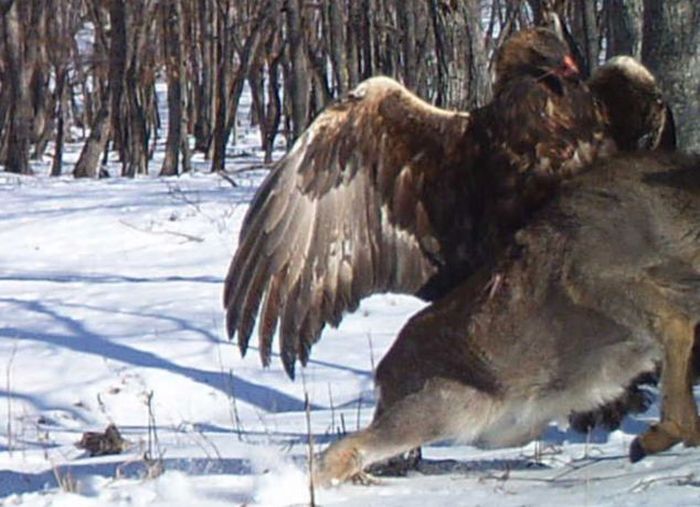|
|
Golden Eagle Hunting A Sika Deer, Lazovsky District, Primorsky Krai, Russia
|
- Aquila chrysaetos homeyeri Severtzov, 1888 –This race occurs in almost the entirety of the Iberian peninsula as well as the island of Crete, though is absent from the rest of continental Europe. It also ranges in North Africa in a narrow sub-coastal strip from Morocco to Tunisia. A completely isolated population of Golden Eagles is found in Ethiopia’s Bale Mountains, at the southern limit of this species range worldwide. Although this latter population has not been formerly assigned to a race, the probability that it belongs with A. c. homeyeri seems high. This subspecies also ranges in much of Asia Minor, mainly Turkey, spottily through the Middle East and the Arabian Peninsula into northern Yemen and Oman to its eastern limits throughout the Caucasus, much of Iran and north to southwestern Kazakhstan. Male wing length is from 55 to 64.3 cm (22 to 25.3 in), averaging 59 cm (23 in), and female wing length is from 60 to 70.5 cm (24 to 27.8 in), averaging 64 cm (25 in). Weight is from 2.9 to 6 kg (6.4 to 13 lb) with no known reports of average masses. This subspecies is slightly smaller and darker plumaged than the nominate race, but is not as dark as the Golden Eagles found further to the east. The forehead and crown are dark brownish with the nape patch being short-feathered and a relatively light rusty color.
- Aquila chrysaetos daphanea Severtzov, 1888 – known variously as the Asian Golden Eagle, Himalayan Golden Eagle or Berikut. This race is distributed in central Kazakhstan, eastern Iran and the easternmost Caucasus distributed to Manchuria and central China and along the Himalayas from northern Pakistan in the west to Bhutan in the east (rarely ranging over into northernmost India) discontinuing in northeastern Myanmar. This subspecies is the largest race on average. Male wing length is from 60 to 68 cm (24 to 27 in), averaging 64 cm (25 in), and female wing length is from 66 to 72 cm (26 to 28 in), averaging 70 cm (28 in). No range of body weights are known but males will weigh approximately 4.05 kg (8.9 lb) and females 6.35 kg (14.0 lb). Although the wingspan of this race reportedly averages 2.21 m (7 ft 3 in), some individuals apparently are much longer-winged. One aforementioned female “Berikut” had an authenticated wingspan of 2.81 m (9 ft 3 in), although she was a captive specimen. It is generally the second darkest race, being blackish on the back. The forehead and crown are dark with a blackish cap near the end of the crown. The feathers of the nape and top-neck are rich brown-red. The nape feathers are slightly shorter than in the nominate race and are similar in length to A. c. homeyeri.
Aquila chrysaetos japonica Severtzov, 1888 – the common name is the Japanese Golden Eagle. This race is found in northern Japan (the islands of Honshu, Hokkaido and discontinuously in Kyushu) and undefined parts of Korea. Male wing length is from 58 to 59.5 cm (23 to 23.4 in), averaging 59 cm (23 in), and female wing length is from 62 to 64.5 cm (24 to 25.4 in), averaging 63 cm (25 in). No range of body weights are known but males will weigh approximately 2.5 kg (5.5 lb) and females 3.25 kg (7.2 lb). This is by far the smallest bodied subspecies. It also the darkest with even adults being a slaty-grayish black on the back and crown and juveniles being similar but with darker black plumage contrasting with brownish color and white scaling on the wings, flank and tail. This race has bright rufous nape feathers that are quite loose and long. Adult Japanese Golden Eagles often maintain extensive white mottling on the inner-webs of the tail that tend to be more typical of juvenile eagles in other races.
- Aquila chrysaetos canadensis (Linnaeus, 1758) – Commonly known as the American Golden Eagle. Occupies the species’ entire range in North America, which compromises the great majority of Alaska, western Canada and the Western United States. The species is found breeding occasionally in all Canadian providences but for Nova Scotia. It is currently absent in the Eastern United States as breeding species east of a line from North Dakota down through westernmost Nebraska and Oklahoma to West Texas. The southern limits of its range are in central Mexico, from the Guadalajara area in the west to the Tampico area in the east. It is the subspecies with the largest breeding range and is probably the most numerous subspecies, especially if A. c. kamtschatica is included. Male wing length is from 59.1 to 64 cm (23.3 to 25 in), averaging 61 cm (24 in), and female wing length is from 60.1 to 67.4 cm (23.7 to 26.5 in), averaging 65 cm (26 in). The average wingspan in both sexes is about 2.04 m (6 ft 8 in). Males weigh from 2.5 to 4.47 kg (5.5 to 9.9 lb), averaging 3.48 kg (7.7 lb), and females typically weigh from 3.6 to 6.4 kg (7.9 to 14 lb), averaging 4.91 kg (10.8 lb). The race does not appear to follow Bergmann’s rule (the rule that widely distributed organisms are larger-bodied further away from the Equator), as specimens of both sexes from Idaho had a mean weight of 4.22 kg (9.3 lb) and where slightly heavier than those from Alaska, with a mean weight of 3.76 kg (8.3 lb). It is medium-sized, being generally intermediate in size between the nominate and A. c. homeyeri but with much overlap. It is blackish to dark brown on the back. The long feathers of nape and top-neck are rusty-reddish and slightly narrower and darker than in the nominate race.
|
|









